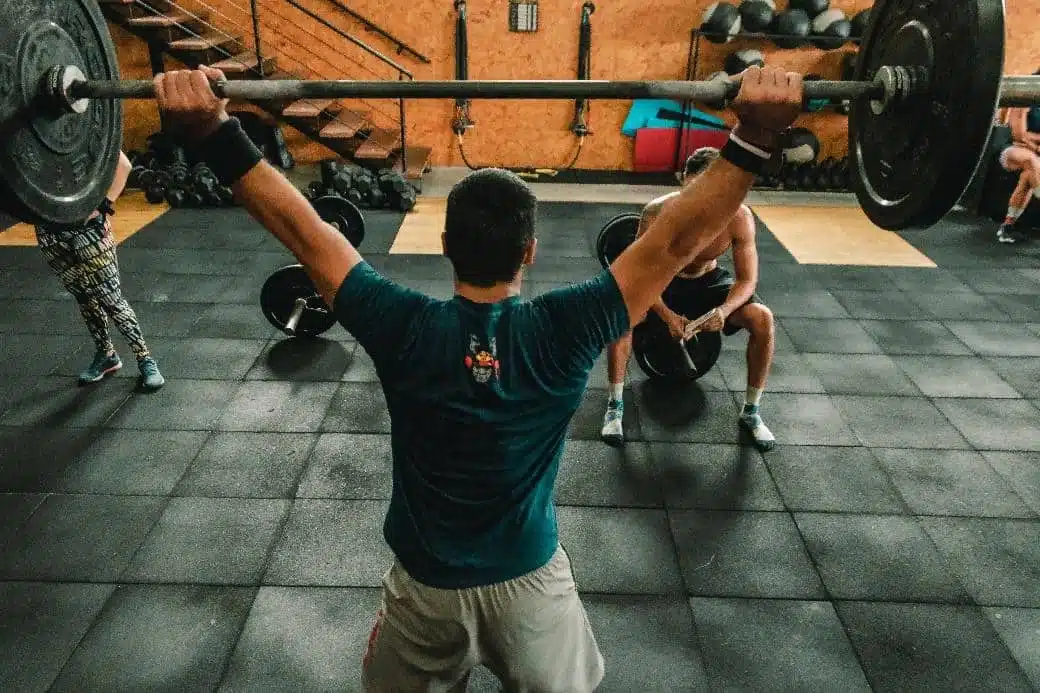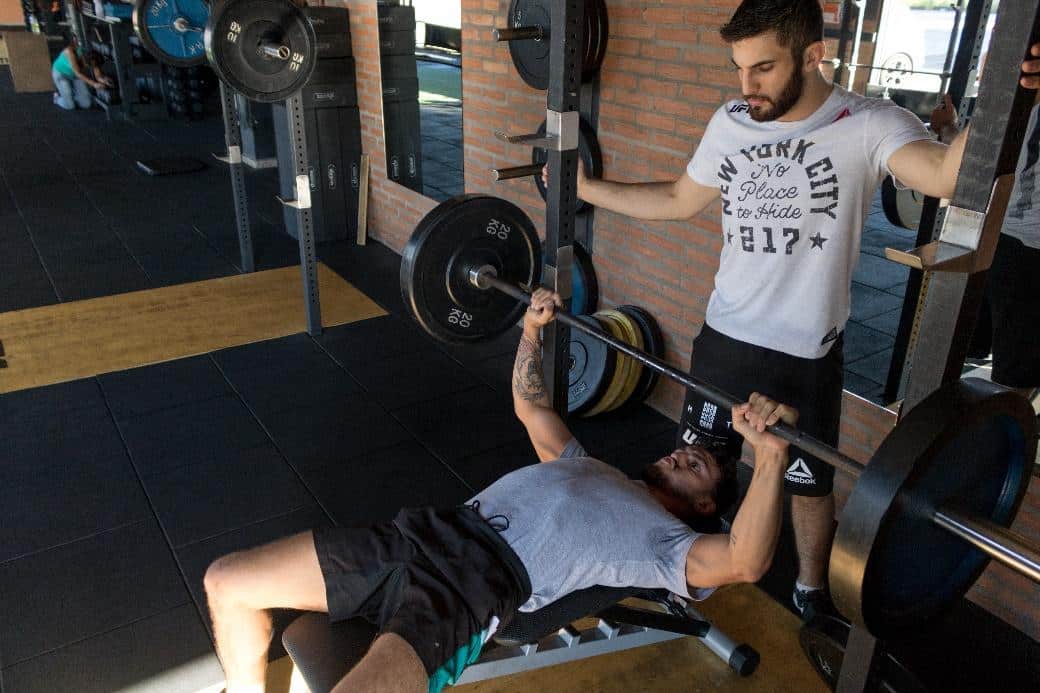28 de November de 2023
Sport tech and science Velocity Based Training
How Fast Should You Move During Power Training?
The Eternal Dilemma: How Fast Should You Move During Power Training?

Hypertrophy, strength, and power are common goals of resistance training, mediated by manipulating numerous variables including load, volume, exercise order, exercise selection, and rest intervals between sets, among others (Bernárdez-Vázquez et al., 2022). However, one often overlooked training variable that is essential to consider for increasing muscle mass, strength, and power is the pace at which we perform repetitions, known as the movement tempo or repetition speed. A recurring question during resistance training is: how fast should you move during Power Training?
In general terms, there are two types of movement tempos during Power Training: involuntary and intentional. Involuntary tempo is dictated by the load, making it impossible to move faster because our capacity doesn’t allow it. Regardless of our desire, if we’re lifting a load close to the maximum, our speed will be slow. When the load allows for more or less acceleration of the bar, the movement tempo becomes intentional because we can make the repetition last longer or shorter. Therefore, conscious and intentional control of movement tempo is only possible to a certain extent (Suchomel et al., 2019a).
Both the load and tempo will determine the total number of repetitions we can perform, with one inseparable from the other. If each repetition takes longer, we will do fewer total repetitions with the same load than we would if the tempo were faster. In this article, we will analyze current scientific literature to answer the common question during Power Training: “how fast should you move?”
Components of Movement: Eccentric, Isometric, and Concentric

Each repetition is composed of four phases of movement: eccentric, isometric or transition, concentric, and once again, isometric or transition (Wilk, Tufano, et al., 2020). The total time for all these phases together is known as the repetition duration. The tempo is usually expressed with four digits (for example, 2 / 0 / 3 / 0). Each digit defines the duration of one of the four phases in each repetition. In the example given, we would have the following tempo:
The first number (2 in the example) refers to the eccentric phase, the phase where force overcomes us. Taking the bicep curl as a sample exercise, the eccentric phase is when the load moves from top to bottom while the elbows extend. Although the exercise starts with the concentric phase, as in the bicep curl, the number referring to the eccentric phase always comes first.
The second and fourth numbers (0 and 0 in the example) belong to the isometric or transition phase. In this case, we don’t pause in this phase, hence it is represented by a zero. In the bicep curl, these phases occur when the arms are fully extended and when they are fully flexed.
The third number (3 in the example) corresponds to the concentric phase, where we overcome the load. In the bicep curl, our muscles contract, lifting the load from bottom to top while flexing the elbows.
The sum of all phases in the example gives a repetition duration of 5 seconds. It’s essential to have a clear understanding of each movement component explained in the previous paragraph because we’ll be talking a lot about the eccentric, isometric, and concentric phases, in addition to presenting digits that show the duration of each.
You can pause and revisit this section whenever needed. If instead of a number in the four-digit sequence, an ‘X’ is shown, it means you should complete the phase as fast as you can. For example, a tempo of 2 / 0 / X / 0 indicates that the concentric phase (the third digit) should be performed at the maximum intentional speed, regardless of the actual bar speed. Even if the load moves slowly, either because it’s heavy or due to fatigue, your intention, if the digit is an ‘X’, should be to move the load as quickly as possible (Wilk, Tufano, et al., 2020).
When we ask ourselves during Power Training, “how fast should you move?” We are referring to each phase separately and collectively. Scientific literature has thoroughly investigated what happens at the muscular and physiological levels when we perform repetitions at different speeds in each phase (Lacerda et al., 2016; Wilk, Tufano, et al., 2020). Instead of discussing the total duration of the repetition, it is more accurate to focus on each phase, especially the concentric and eccentric phases, rather than the isometric phase. This allows for the possibility of moving slowly in the eccentric phase and slowly in the concentric phase, or any possible variation (both phases fast, both phases slow…). Let’s try to detail the duration and execution speed that each repetition should have in weight training with the goal of gaining muscle mass, strength, and power, or rather, when we should move slowly, when quickly, and try to determine how much of each.
It’s Not Just About “How Fast Should You Move During Power Training?”

Remember when Doc told Marty McFly in Back to the Future, “anything you mess with can have a direct impact”? He was talking about how Marty’s time-traveling adventures could totally change things if he messed with stuff in the past. Well, the speed of your lifts works the same way. Choosing a tempo can mess with the number of reps you do (Sakamoto & Sinclair, 2006), the time your muscles are under tension (Wilk et al., 2018), and how much weight you can lift max (Headley et al., 2011). They’re all connected, man. Change one, and the others get thrown for a loop. So, muscle growth and strength gains might go up or down depending on how you tweak your lifting speed, and it’s tied to a bunch of other factors.
Take ‘time under tension’ (TUT), for example. It’s been a big deal for a while, but turns out, it’s influenced by things like lift speed and how much weight you’re pushing (Mang et al., 2022). Lift a light load fast, and you can do loads of reps with a lot of time under tension. Go slow intentionally, and you’re looking at fewer reps and less TUT. This is where things get tricky, and there’s no clear agreement on how fast or slow we should be moving. But science throws some tips our way to get the most out of Power Training (Trybulski et al., 2022).
In a nutshell, the American College of Sports Medicine links different lift speeds to athlete levels (“American College of Sports Medicine Position Stand. Progression Models in Resistance Training for Healthy Adults,” 2009). Newbies should stick to slow and moderate speeds, intermediate folks can handle moderate tempos, and advanced athletes can mix it up from slow to fast. But here’s the catch: many scientific papers on tempo, muscle, and strength make a big mistake. They talk about “fast” or “slow” without breaking down each phase of the movement.
A literature review dug into how variations in lift speed affect long-term strength and muscle adaptations to resistance training (Wilk et al., 2021). They didn’t just look at the total time for a rep but focused on the speed of each of the four phases of movement. That’s where the real deal is, man. So, answering the question, “how fast should you move during Power Training?” with a simple “fast” or “slow” doesn’t cut it.
How Fast Should You Move During Power Training to Gain Muscle Mass?

The findings from research suggest that a wide range of movement tempos can be used during resistance training to stimulate muscle hypertrophy (Schoenfeld et al., 2015). Evidence indicates that intentionally slowing down the tempo of a single repetition increases time under tension (TUT) and may enhance muscle activation for a specific number of reps (Burd et al., 2012; Wilk, Tufano, et al., 2020).
Hypothetically, increased muscle activity combined with a longer TUT could positively mediate intracellular anabolic signaling, promoting a greater hypertrophic response (Schoenfeld et al., 2015). However, the anabolic process is complex, and a change in one variable (e.g., tempo) can directly or indirectly affect other variables that also play a crucial role in anabolic processes (e.g., load, number of reps, TUT, fatigue, etc.) (Wilk, Tufano, et al., 2020).
Slowing down the tempo may compensate for the decrease in load when the training goal is hypertrophy; that’s the conclusion of Tanimoto & Ishii (2006), who found similar hypertrophic results with high loads moved quickly compared to low loads moved more slowly. In another study, they found that following a 3/0/3/0 tempo with 60% loads produced similar hypertrophic effects compared to a group using the 1/0/1/1 tempo with 80-90% loads (Tanimoto et al., 2008). These results highlight that tempo is part of a complex web of variables that lead to different mechanical stimuli.
Using the same load but doing one set with a slow tempo and another set with a fast tempo will result in different time under tension and rep numbers, but overall, hypertrophic adaptations will be very similar if we reach muscle failure (Wilk et al., 2018). Intentionally slowing down the tempo in reps with low loads allows for a higher TUT, but with lower force requirements, we might be decreasing muscle activity and hypertrophic adaptations.
Considering all this and based on one of the most cited meta-analyses on the topic, the general recommendation isn’t clear-cut, spanning a broad range from total rep duration of 0.5 to 8 seconds (Wilk, Tufano, et al., 2020). Within this duration range, adaptations were similar, but if we exceeded 8 seconds per rep, known as ‘super slow reps,’ hypertrophic effects worsened.
So far, we’ve learned that if our goal is muscle gain, we can do reps faster or slower, as long as it’s not too slow (more than 8 seconds per rep). However, we still need to break down that total duration into each phase of the movement. It’s crucial to differentiate the effects of concentric and eccentric durations on muscle mass increase (Suchomel et al., 2019a). If we only focus on total duration, we miss something fundamental: knowing which phase to do faster, which one slower, or if we should maintain the same tempo throughout the entire execution (Schoenfeld et al., 2017).
Eccentric Time Under Tension for Muscle Gain
It’s not just about total time under tension (TUT) for the entire movement; we also need to break it down independently for each of its phases: eccentric TUT and concentric TUT. In this section, we’ll focus on the eccentric part, which, just a reminder, is when the load overcomes us. It could be when we’re lowering down in a squat or when we’re bending our arms, and the bar approaches the chest in a bench press.
Schoenfeld, a big name in muscle hypertrophy, emphasizes that hypertrophy occurs to a greater extent when the duration of the eccentric phase increases (Schoenfeld, 2010). A slower eccentric movement increases metabolic stress, hormonal responses, muscle fiber damage, and protein breakdown, inducing a stronger anabolic signal within the muscle (Wilk et al., 2021).
However, some studies have extended the eccentric phase to 10 seconds per repetition with a very slow tempo (4/0/10/0), yielding contradictory results. The reason is that to follow such slow movement tempos, it’s necessary to use light loads or perform very few repetitions, which is suboptimal for maximizing muscle hypertrophy gains (Schoenfeld et al., 2015). In finding the right balance, a study by Pereira and colleagues (Eduardo Assis Pereira et al., 2016) observed greater muscle increases when the eccentric tempo was slower (4/0/1/0) instead of faster (1/0/1/0).
Another parameter to consider when extending the eccentric phase is the subjective effort, which increases as this phase slows down. A movement tempo of 4/0/2/0 produced greater subjective effort in athletes compared to a tempo of 2/0/2/0 (Diniz et al., 2014). Therefore, while the eccentric phase should be extensive, it’s generally recommended not to exceed three or four seconds in duration.
Maximizing Muscle Mass: The Significance of Concentric Time Under Tension (TUT)
In contrast to the recommendation for a slower eccentric contraction, it appears beneficial to use faster concentric contractions for muscle hypertrophy. Performing this phase more quickly enhances muscle activation and results in less repetition fatigue, allowing for a greater number of repetitions to be completed (Hoelting et al., 2001). Several studies have shown that faster concentric contractions (3/0/1/0) led to greater muscle hypertrophy (CSA) compared to slower concentric contractions (3/0/3/0) (Keeler et al., 2001; Nogueira et al., 2009). Therefore, if you want to extend the duration of the repetition, do it in the eccentric phase, but make the concentric phase quick.
Closing In on the Answer: How Fast to Move for Muscle Gain in Power Training
It seems that the most favorable approach involves a combination of a slower movement in the eccentric phase with a faster movement during the concentric phase. However, the optimal use of variable movement tempos to enhance muscle hypertrophy cannot be analyzed independently of other training variables (especially load, number of repetitions, TUT, etc.) (Wilk et al., 2021).
If we had to take a stand and answer the question “During Power Training, how fast should you move to gain muscle mass?” we would suggest a movement tempo of 3/1/1/1 or 3/0/1/0 as a good general recommendation. Three seconds in the eccentric phase – not too much, not too little. This way, we harness the hypertrophic benefits of this phase without causing excessive fatigue or increasing the effort’s subjective nature.
One second in the isometric or transition phases – a chance to take a breather if there’s no tension or to leverage the contraction peak if tension is present. You can also skip this transition phase if there’s no muscular tension.
One second in the concentric phase, which in some cases could even be explosive (marked with an ‘X’), although this explosiveness is more interesting if the goal is to gain strength and power. In this phase, speed is key, leaving the slow movement for the eccentric phase.
Finding the Right Pace: Speed Recommendations for Building Muscle Strength and Power in Power Training

Among various training variables, movement tempo stands out as an acute factor that can be manipulated to potentially optimize the development of maximum strength and power (Headley et al., 2011; Wilk, Golas, et al., 2020). As discussed earlier, more crucial than the total duration of the repetition is how quickly or slowly the different phases of the movement are executed. The objective here is quite different from the previous section, especially when considering power. As you might imagine, the answer to the question “How fast should you move during Power Training?” is somewhat simpler.
The consensus from a significant body of scientific literature details that relatively small changes in movement tempo do not impact strength gains (Carlson et al., 2019; Gepfert et al., 2021; Lacerda et al., 2021). However, we emphasize once again the importance of distinguishing between the eccentric and concentric phases regarding the total duration of the repetition. One crucial detail when training with the goal of gaining maximum strength is that heavy loads play a starring role, a factor that doesn’t carry as much weight in muscle hypertrophy. When you have a 90% load in a back squat, you want to get it off quickly, right?
Rather than relying solely on scientific articles in this section, let’s turn to common sense. Similar to the recommended tempo for muscle hypertrophy, there is no consensus on the perfect duration or speed for gaining strength. As mentioned earlier in this blog post, we differentiated between involuntary and intentional movement tempo. When dealing with heavy loads, there is little room to move them intentionally slowly; instead, the movement tends to be involuntary because we physically can’t move them faster— the load doesn’t allow it. The nuance in training for strength and power is that, even if the load moves slowly, our intention should be to move it as quickly as possible in the concentric phase.
A phrase echoes through the consulted studies repeatedly: the duration of repetitions does not affect strength gains in trained participants when the exercise is performed to muscular failure (Carlson et al., 2019). The catch is that it is not recommended to reach muscular failure for gaining muscle strength and power, and that significantly alters the results. The optimal movement tempo for our goal differs when striving for the fastest execution possible without reaching muscular failure compared to a set with a slower pace, also staying away from muscular failure. When aiming for muscle hypertrophy, getting close to or reaching muscular failure is necessary, but for gaining strength and power, it changes the optimal movement tempo for our objective.
Harnessing Eccentric Time Under Tension for Muscle Strength and Power Gains
Literature has demonstrated that intentionally lengthening the eccentric duration can result in suboptimal strength adaptations compared to faster eccentric actions (Suchomel et al., 2019b, 2019a). The eccentric phase is easier to control than the concentric phase with heavy loads since we are stronger in this part of the movement. However, exceeding time in the eccentric phase can severely limit energy, the number of repetitions, and the speed at which we can approach the concentric phase (Westcott et al., 2001; Wilk et al., 2019). Imagine tackling a heavy bench press set, lowering the bar very slowly. Will you lose energy to push that bar back up? Clearly, yes.
As we just discussed, our goal when aiming for muscle mass and power is not to fatigue but to provide maximum stimulus with minimal fatigue. To achieve this, the eccentric phase should have a minimal duration that allows for load control while avoiding technical failures and injuries, without intentionally lengthening it. If we had to suggest a figure, a duration of two seconds might fit most movements, providing sufficient time to control the load in this phase without adversely affecting the subsequent concentric phase. Of course, this is a very general estimate, as in some exercises like the deadlift, enduring a two-second descent with near-maximum loads can be challenging.
The same applies to the eccentric phase of a repetition for power involving a preceding gesture, such as a vertical jump. In this case, the duration of the eccentric phase would be represented with an “X” because it should be done as quickly as possible. In summary, while the eccentric phase is crucial for muscle hypertrophy, for strength, although important, we shouldn’t obsess over it.
Elevating Strength and Power: Concentric Time Under Tension for Muscle Enhancement
Executing slow concentric movements with heavy external loads, especially in multi-joint exercises like squats or deadlifts, is highly challenging. Moreover, a faster movement tempo in the concentric phase provides a superior stimulus for neural adaptations that lead to greater strength gains. The key finding from a recently published meta-analysis leaves no room for doubt: when concentric Power Training speeds exceed 2 seconds or are intentionally slow in nature, strength gains are diminished (Hermes & Fry, 2023).
Extending beyond that 2-second threshold intentionally requires lowering the loads to cope with them, which is a mistake, as heavy loads are crucial for strength gains. It’s essential to note that intentional speed is emphasized throughout, signifying consciously moving the load slowly. While a heavy load cannot be moved quickly, we refer to involuntary tempo when there’s an intention to move it quickly, even if the actual movement is slow. When moving a load in the concentric phase, it can be done quickly (specified as “1” in the digit sequence) or explosively at maximum speed (specified as “X” in the digit sequence).
For those pursuing maximal strength without delving into sports performance or power, moving the load quickly is imperative. Attempt a slow-paced weighted pull-up from the start, and you’ll notice you get stuck midway. However, commencing the movement with high velocity allows overcoming that sticking point by reaching it with some speed.
It’s not groundbreaking to state that, to gain power, we need to execute explosive movements as quickly as possible (an “X” in the movement tempo digit sequence). The specificity of training determines its effectiveness, and if we aim for changes in direction, jumping, swinging a bat, throwing a punch, or any explosive gesture, we must train the concentric phase at maximum speed. There’s no doubt about it – regardless of the load used, low or high, we should always move it as quickly as possible, even if it appears slow due to the challenging weight.
“Navigating Speed in Power Training: Conclusive Insights for Muscle Strength and Power Enhancement
The current literature doesn’t decisively pinpoint the most effective movement tempo for muscle strength development. To maximize it, controlled slower tempos should be reserved for the eccentric phase only (Hermes & Fry, 2023). However, the concentric phase should be swift or explosive depending on the context and objective. The eccentric phase, when performing repetitions to enhance power, should align with the demand, allowing for explosiveness, especially if it involves a preceding counter-movement, such as in a jump. The concentric phase, in this case, should be executed at maximum intentional speed, irrespective of the actual bar speed.
To measure the speed at which we move the load, devices like Vitruve provide real-time velocity data, along with various other metrics like power, range of motion, etc. This allows athletes not only to gauge their speed but also offers instant feedback, serving as motivation to perform each repetition at maximum velocity.
While there’s no clear-cut movement tempo for developing strength and power, it can be narrowed down to the following recommendation. For maximal strength and power gains, a suggested movement tempo could be 2 / 0 / 1 / 0 or 2 / 0 / X /
- Two seconds in the eccentric phase to master load control, as less time could pose risks and negatively impact the subsequent concentric phase by abruptly halting the load. More than two seconds might induce unnecessary fatigue, although if it contributes to muscle growth, it can positively affect maximal strength.
- In the transition or isometric phase, there’s no lingering, or it’s done very briefly for a breath. When handling a significant load, every second counts, and spending time in these phases might not be the wisest choice.
- One second in the eccentric phase or an “X” to emphasize moving the load quickly or at the maximum intentional speed—vital for sports performance and power.
References
American College of Sports Medicine position stand. Progression models in resistance training for healthy adults. (2009). Medicine and Science in Sports and Exercise, 41(3), 687–708. https://doi.org/10.1249/MSS.0B013E3181915670
Bernárdez-Vázquez, R., Raya-González, J., Castillo, D., & Beato, M. (2022). Resistance Training Variables for Optimization of Muscle Hypertrophy: An Umbrella Review. Frontiers in Sports and Active Living, 4, 949021. https://doi.org/10.3389/FSPOR.2022.949021/BIBTEX
Burd, N. A., Andrews, R. J., West, D. W. D., Little, J. P., Cochran, A. J. R., Hector, A. J., Cashaback, J. G. A., Gibala, M. J., Potvin, J. R., Baker, S. K., & Phillips, S. M. (2012). Muscle time under tension during resistance exercise stimulates differential muscle protein sub-fractional synthetic responses in men. The Journal of Physiology, 590(2), 351–362. https://doi.org/10.1113/JPHYSIOL.2011.221200
Carlson, L., Jonker, B., Westcott, W. L., Steele, J., & Fisher, J. P. (2019). Neither repetition duration nor number of muscle actions affect strength increases, body composition, muscle size, or fasted blood glucose in trained males and females. Applied Physiology, Nutrition, and Metabolism = Physiologie Appliquee, Nutrition et Metabolisme, 44(2), 200–207. https://doi.org/10.1139/APNM-2018-0376
Diniz, R. C. R., Martins-Costa, H. C., Machado, S. C., Lima, F. V., & Chagas, M. H. (2014). Repetition duration influences ratings of perceived exertion. Perceptual and Motor Skills, 118(1), 261–273. https://doi.org/10.2466/03.06.PMS.118K11W6
Eduardo Assis Pereira, P., Lopes Motoyama, Y., Jesus Esteves, G., Carlos Quinelato, W., Botter, L., Hiroyuki Tanaka, K., & Azevedo, P. (2016). Resistance training with slow speed of movement is better for hypertrophy and muscle strength gains than fast speed of movement. https://doi.org/10.30472/ijaep.v5i2.51
Gepfert, M., Trybulski, R., Stastny, P., & Wilk, M. (2021). Fast Eccentric Movement Tempo Elicits Higher Physiological Responses than Medium Eccentric Tempo in Ice-Hockey Players. International Journal of Environmental Research and Public Health, 18(14), 7694. https://doi.org/10.3390/IJERPH18147694
Headley, S. A., Henry, K., Nindl, B. C., Thompson, B. A., Kraemer, W. J., & Jones, M. T. (2011). Effects of lifting tempo on one repetition maximum and hormonal responses to a bench press protocol. Journal of Strength and Conditioning Research, 25(2), 406–413. https://doi.org/10.1519/JSC.0B013E3181BF053B
Hermes, M. J., & Fry, A. C. (2023). Intentionally Slow Concentric Velocity Resistance Exercise and Strength Adaptations: A Meta-Analysis. Journal of Strength and Conditioning Research, 37(8), E470–E484. https://doi.org/10.1519/JSC.0000000000004490
Hoelting, B. D., Scheuermann, B. W., & Barstow, T. J. (2001). Effect of contraction frequency on leg blood flow during knee extension exercise in humans. Journal of Applied Physiology (Bethesda, Md. : 1985), 91(2), 671–679. https://doi.org/10.1152/JAPPL.2001.91.2.671
Keeler, L. K., Finkelstein, L. H., Miller, W., & Fernhall, B. O. (2001). Early-Phase Adaptations of Traditional-Speed vs. Superslow Resistance Training on Strength and Aerobic Capacity in Sedentary Individuals. National Strength & Conditioning Association J. Strength Cond. Res, 15(3), 309–314.
Lacerda, L. T., Marra-Lopes, R. O., Lanza, M. B., Diniz, R. C. R., Lima, F. V., Martins-Costa, H. C., Pedrosa, G. F., Andrade, A. G. P., Kibele, A., & Chagas, M. H. (2021). Resistance training with different repetition duration to failure: effect on hypertrophy, strength and muscle activation. PeerJ, 9. https://doi.org/10.7717/PEERJ.10909
Lacerda, L. T., Martins-Costa, H. C., Diniz, R. C. R., Lima, F. V., Andrade, A. G. P., Tourino, F. D., Bemben, M. G., & Chagas, M. H. (2016). Variations in Repetition Duration and Repetition Numbers Influence Muscular Activation and Blood Lactate Response in Protocols Equalized by Time Under Tension. Journal of Strength and Conditioning Research, 30(1), 251–258. https://doi.org/10.1519/JSC.0000000000001044
Mang, Z. A., Realzola, R. A., Ducharme, J., Bellissimo, G. F., Beam, J. R., Mermier, C., de Castro Magalhaes, F., Kravitz, L., & Amorim, F. T. (2022). The effect of repetition tempo on cardiovascular and metabolic stress when time under tension is matched during lower body exercise. European Journal of Applied Physiology, 122(6), 1485–1495. https://doi.org/10.1007/S00421-022-04941-3/METRICS
Nogueira, W., Gentil, P., Mello, S. N. M., Oliveira, R. J., Bezerra, A. J. C., & Bottaro, M. (2009). Effects of power training on muscle thickness of older men. International Journal of Sports Medicine, 30(3), 200–204. https://doi.org/10.1055/S-0028-1104584
Sakamoto, A., & Sinclair, P. J. (2006). Effect of movement velocity on the relationship between training load and the number of repetitions of bench press. Journal of Strength and Conditioning Research, 20(3), 523–527. https://doi.org/10.1519/16794.1
Schoenfeld, B. J. (2010). The mechanisms of muscle hypertrophy and their application to resistance training. Journal of Strength and Conditioning Research, 24(10), 2857–2872. https://doi.org/10.1519/JSC.0B013E3181E840F3
Schoenfeld, B. J., Ogborn, D. I., & Krieger, J. W. (2015). Effect of Repetition Duration During Resistance Training on Muscle Hypertrophy: A Systematic Review and Meta-Analysis. Sports Medicine, 45(4), 577–585. https://doi.org/10.1007/S40279-015-0304-0/METRICS
Schoenfeld, B. J., Ogborn, D. I., Vigotsky, A. D., Franchi, M. V., & Krieger, J. W. (2017). Hypertrophic Effects of Concentric vs. Eccentric Muscle Actions: A Systematic Review and Meta-analysis. Journal of Strength and Conditioning Research, 31(9), 2599–2608. https://doi.org/10.1519/JSC.0000000000001983
Suchomel, T. J., Wagle, J. P., Douglas, J., Taber, C. B., Harden, M., Gregory Haff, G., & Stone, M. H. (2019a). Implementing Eccentric Resistance Training-Part 1: A Brief Review of Existing Methods. Journal of Functional Morphology and Kinesiology, 4(2). https://doi.org/10.3390/JFMK4020038
Suchomel, T. J., Wagle, J. P., Douglas, J., Taber, C. B., Harden, M., Gregory Haff, G., & Stone, M. H. (2019b). Implementing Eccentric Resistance Training-Part 2: Practical Recommendations. Journal of Functional Morphology and Kinesiology, 4(3). https://doi.org/10.3390/JFMK4030055
Tanimoto, M., & Ishii, N. (2006). Effects of low-intensity resistance exercise with slow movement and tonic force generation on muscular function in young men. Journal of Applied Physiology (Bethesda, Md. : 1985), 100(4), 1150–1157. https://doi.org/10.1152/JAPPLPHYSIOL.00741.2005
Tanimoto, M., Sanada, K., Yamamoto, K., Kawano, H., Gando, Y., Tabata, I., Ishii, N., & Miyachi, M. (2008). Effects of whole-body low-intensity resistance training with slow movement and tonic force generation on muscular size and strength in young men. Journal of Strength and Conditioning Research, 22(6), 1926–1938. https://doi.org/10.1519/JSC.0B013E318185F2B0
Trybulski, R., Gepfert, M., Gawel, D., Bichowska, M., Fostiak, K., Wojdala, G., Trybek, G., Krzysztofik, M., & Wilk, M. (2022). Impact of movement tempo on bar velocity and time under tension in resistance exercises with different external loads. Biology of Sport, 39(3), 547. https://doi.org/10.5114/BIOLSPORT.2022.106160
Westcott, W. L., Winett, R. A., Anderson, ; E S, & Wojcik, J. R. (2001). Effects of regular and slow speed resistance training on muscle strength. Journal of Sports Medicine and Physical Fitness, 41(2).
Wilk, M., Gołaś, A., Krzysztofik, M., Nawrocka, M., & Zając, A. (2019). The Effects of Eccentric Cadence on Power and Velocity of the Bar during the Concentric Phase of the Bench Press Movement. Journal of Sports Science & Medicine.
Wilk, M., Golas, A., Stastny, P., Nawrocka, M., Krzysztofik, M., & Zajac, A. (2018). Does Tempo of Resistance Exercise Impact Training Volume? Journal of Human Kinetics, 62(1), 241–250. https://doi.org/10.2478/HUKIN-2018-0034
Wilk, M., Golas, A., Zmijewski, P., Krzysztofik, M., Filip, A., Coso, J. Del, & Tufano, J. J. (2020). The Effects of the Movement Tempo on the One-Repetition Maximum Bench Press Results. Journal of Human Kinetics, 72(1), 151. https://doi.org/10.2478/HUKIN-2020-0001
Wilk, M., Tufano, J. J., & Zajac, A. (2020). The Influence of Movement Tempo on Acute Neuromuscular, Hormonal, and Mechanical Responses to Resistance Exercise-A Mini Review. Journal of Strength and Conditioning Research, 34(8), 2369–2383. https://doi.org/10.1519/JSC.0000000000003636
Wilk, M., Zajac, A., & Tufano, J. J. (2021). The Influence of Movement Tempo During Resistance Training on Muscular Strength and Hypertrophy Responses: A Review. Sports Medicine (Auckland, N.z.), 51(8), 1629. https://doi.org/10.1007/S40279-021-01465-2

